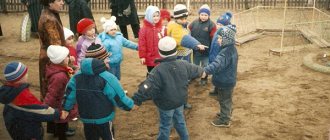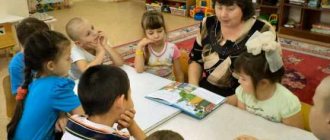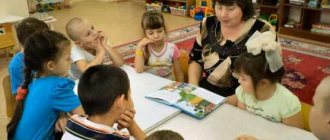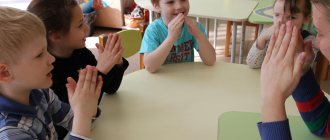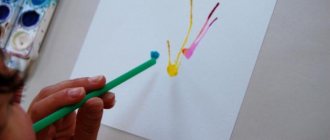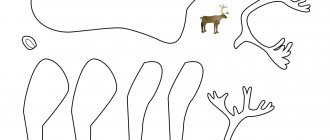Why are conversations held in a preliminary group?
In the senior and preliminary groups, the range of topics for discussion expands significantly. At the same time, the content of the conversation, determined by the program material (familiarization with the required set of abilities in various professions, history, concepts of rights and obligations, etc.) and the types of activities of the children (games, work activity), is expanded by discussing the personal experience of the children in either on another issue. Which, in turn, determines the motivated guidelines of this verbal technique:
- teaches to draw conclusions on a particular topic, drawing on their practical and sensory experience (for example, when talking about positive and negative characters in parables, kids can look for excellent traits in “bad” characters, focusing on their feelings, for example, sympathizing with the wolf from “The Three Little Pigs”, who simply wanted to eat, that’s why he behaved this way, and perhaps it was unpleasant for him himself);
- activation of monologue and dialogic speech of children (the teacher’s word should be less than ? of the entire conversation);
- cultivate respect for someone else’s point of view (since the questions of the conversation are mainly of a problematic nature, children’s ideas, especially with regard to evaluating actions, may differ).
During the conversation, the guys learn to intelligently construct monologues and understand the discussion in a timely manner.
Solving the following tasks helps to realize these goals of the conversation:
- building a conversation around problematic or exploratory issues;
- increasing the level of speech quality due to an increase in the proportion of monologues and dialogues, and the child’s expression corresponds to compositional laws, in other words, it has a beginning, a demonstrative disclosure of the topic of the question, a conclusion;
- developing the ability to defend and justify one’s point of view, drawing on personal experience.
Types of conversations in the preliminary group, card files
Discussions with children 6–7 years old are diverse not only in topic, but also in type. In other words, in the preliminary group the teacher organizes conversations of all types, practiced in kindergarten. And, as in the past year, increased attention is paid to discussions of cognitive and ethical directions.
In the preliminary group, conversations on educational and ethical topics predominate
Table: examples of cognitive and ethical conversations in the preliminary group
Creator - Vasylishin N.A., teacher of kindergarten, school-gymnasium No. 60, Lugansk.
- classify knowledge of traffic rules for pedestrians;
- make sure of the threat of games on the roadway.
Kids play the game "Scooter". To the rhythm of the rhyme, bend one leg at the knee, imitate the push-off movement with the other leg, sliding it along the floor:
- Scooter! Scooter! Scooter, very happy! I roll it myself, I roll the scooter myself, wherever I want!
After this, the kids answer the questions:
- “Why is it unsafe to play on the pavement?”;
- “Where can I skate, ski, scooter?” and etc.
- to form an idea of man as a rational being, who is at the same time a part of nature;
- attract to research activities;
- develop monologue and dialogic speech;
- provoke a creative view of the world.
- cultivate respect for bread and people whose professions are related to the creation of bread;
- Learn to write a story using pictures.
The teacher asks what kind of bread there is. The kids answer that it is snow-white, black, soft, stale, etc. An adult knows about the technology of bread production. Kids, selecting illustrations in an appropriate order, summarize the stages of this process. The game “Who is more”: the teacher throws a ball to the children, they name any baked product. Physical education minute:
- A grain fell into the ground (they crouch) It began to sprout in the sun (hands above your head) The rain watered the ground, and the sprout grew (they slowly stand up) It reached out to the light and warmth And turned into a handsome man.
The kids make up one sentence each with the name of any bakery product. Result: bread is the boss of everything.
- classify the idea of vegetables and their significance for the human body;
- find out which animals help grow a good harvest.
The teacher asks the kids to lay out the vegetables on two mats: one is black, on it you need to put those vegetables from which we eat the roots, and the second is green, on it you need to place those crops from which we eat the tops. The teacher asks to name animals that are good for vegetables. Kids look at the drawings and comment on the illustrations:
- moles and worms dig the ground, and the roots breathe;
- frogs eat slugs that spoil cabbage.
The result of the conversation: vegetables are very useful, but to grow them, you need to put in a lot of work.
- formation of a collective view of the mother;
- foster the need to provide assistance to mothers in everyday matters.
Then the teacher asks the children to tell about their own mother: what the child feels for his own mother, what words he says to her. The teacher turns to the children for an explanation of the concept of “golden hands” and asks them to tell how children help their mothers around the house. Then the teacher organizes a ball game “How I Help Mom”: he throws the ball to the children one by one, they catch it and say how they help. Result: the family rests on the mother, the kids must help her.
- expand the understanding of the concept of family;
- clarify knowledge of similar relationships;
- develop the skill of evaluating your own actions and the actions of other people.
After this, the kids play the “Family” lotto: everyone receives cards with a picture of their mother, father, grandmother, etc. Then, in turn, they take a small card out of the box with an illustration of some activity and place it next to their relatives in order. For example, “Grandfather and I are making dumplings.” If there was none, the small card must be returned to the box. The one who closes all the cards wins. Kids define the concept of family, remember proverbs and sayings on the topic. The teacher tells the fairy tale “The Family of Wizards”: “In one ordinary family of wizards, the indescribable happened: the boy Vasya stopped obeying his mother, who asked him to clean his running boots. Then the mother announced that she would not listen to the father: he would come home from work and ask to lay out a self-assembled tablecloth, and the mother would say that she had given it to the dry cleaner. Dad heard this and announced that he, too, was now no longer listening to grandfather: he would tell dad to clean the flying carpet of dust, and dad would refuse him. And grandfather also did not remain in debt: it says, they say, that’s it, I will no longer obey my grandmother: water her magical apple tree or feed her goldfish. The grandmother looked at Vasya and declared that she would no longer obey him and would not tie the invisibility cap. Vasya thought about it, thought about it, and decided that he needed to obey his mother, and then others would help each other. This is how they will have a magical family.” The teacher asks the children if their families are wonderful. Result: family is love, care and respect.
- classify the concepts of “friend”, “friendship”;
- learn to recognize and evaluate the actions of other people;
- develop communication abilities;
- cultivate responsiveness.
Kids remember proverbs about friendship, and then select drawings that are suitable in content to the stories “Three Comrades” by V. Oseeva, “Childhood Friend”, “Friends Known in Trouble” by V. Dragunsky. The teacher offers to play the game “Living Pictures”: one mini-group receives a picture and uses gestures and facial expressions to describe what is happening on it. The 2nd mini-group tries to describe their pantomime in words. The conversation ends with the game “Caterpillar”: kids with balls stand in a column one at a time, holding the ball between their tummy and the back of the comrade in front. So, to the song “If you went on a journey with a friend,” the kids move around the room. The teacher and the children sum up the result: friends must be saved.
- classify knowledge of the rules of appeal with books;
- cultivate respect for printed publications.
Dunno realizes that he behaved incorrectly and invites the children to paste in a page to read the story. The teacher finishes reading and together with the children sums up the result: books need to be saved.
This is interesting. The content of cognitive and ethical conversations in the preliminary group is closely intertwined, because the age of the children allows us to consider this or that issue from different angles, touching on both one and the other area.
The topic of cognitive and ethical conversations in the preliminary group is closely intertwined
Files of conversations of various types in the preliminary group
As in the older group, compiling a file of conversations with children 6–7 years old is based on the principle of grouping by topic or educational direction. Card indexes on the topic are convenient because it makes it easier for the teacher to choose a conversation that is suitable for a particular lesson. For example, you can get acquainted with a prototype of a card index on a specific topic on the topic “Family” in the work of teacher Zarubka O.S.
Due to the growing number of topics being studied, organizing a file cabinet by educational area is a more comfortable option. Thus, an example of a block of conversations on promoting a healthy lifestyle can be found in the work of teacher M.I. Tozikova.
It is very important when working with children 6–7 years old to repeat and enrich cultural and hygienic abilities. Therefore, it is impossible to do without conversations in this area. An option for compiling a card index can be seen in the publication of teacher Lomovskaya L.V.
The calendar-thematic plan for situational conversations in the preliminary group on various topics is presented in the work of L. Lisenkova here
Conversations of a precedent nature can also be conducted by invited specialists. For example, a conversation with a law enforcement representative about the nuances of traffic or with a doctor about the importance of vaccinations.
In the preliminary group, morning conversations remain more pressing, giving an idea of the topic of the day, which also allows you to select a problem for situational discussion, in other words, a question that arose during the children’s stay in the group. You can get an idea of this block of conversations in the publication of teacher D.S. Nishchetova.
This is interesting. Due to the peculiarities of the format of personal conversations, and specifically the organization, if necessary, their topic is taken from blocks on certain educational areas: for example, from a card index on KGN, if a child forgets to wash his hands or eats sloppily.
Compiling conversation files simplifies the selection of a suitable conversation for the topic of a segment of the educational process
Card index of thematic conversations with children
Educational activities in special moments.
Senior – preparatory group.
Card index of thematic conversations with children
senior preschool age (“Autumn”, “Winter”, “Spring”, “Summer”)
Explanatory note.
We present to your attention a collection of methodological materials for planning work in a compensatory group for children of senior preschool age. It is recommended to all those who work with children of this age, and most importantly, it will be useful to those who care about expanding the vocabulary of children. After all, it is
A properly structured conversation and thoughtful questions contribute to active engagement with a lexical topic, enriching their knowledge and accumulating lexical material. The material is systematized into blocks: “Autumn”, “Winter”, “Spring”, “Summer”.
During the conversation, monitor whether children construct phrases and sentences correctly, whether they correctly agree adjectives and numerals with nouns. Develop the ability to adhere to the chosen plot line in a story.
| AUTUMN |
| Topic: “Autumn. What do you know about her? Questions for the conversation.
|
| Topic: “Trees in our yard” Questions for the conversation.
|
| Topic: “Walk in the Garden” Questions for the conversation.
|
| Topic: “Walk in the garden” Questions for the conversation.
|
| Topic: “Bread is the head of everything” Questions for the conversation.
|
| Topic: “How we looked for mushrooms” Questions for the conversation.
|
| Topic: “Late Autumn” Into the polls for the conversation.
(O.A. Skorolupova. Autumn. Part 2) |
| WINTER |
| Topic: “Where does the bear live?” Questions for the conversation.
|
| Subject: "Winter Signs" Questions for the conversation.
|
| Topic: “Have a fun, fun New Year!” Questions for the conversation.
Topic:
Dressy, funny, I’m in charge for the New Year! Guess who I am?
|
| Topic: “Funny stories about kind animals.” Questions for the conversation.
During the conversation, monitor whether children construct phrases and sentences correctly, whether they correctly agree adjectives and numerals with nouns. Develop the ability to adhere to the chosen plot line in a story. |
| Topic: “Barnyard Inhabitants” Into the polls for the conversation.
|
| Subject: "Cars on our street" Questions for the conversation.
|
| Topic: “Your fairy ship” Questions for the conversation.
Come up with some interesting story that happened to your ship. |
| Topic: “Air modes of transport” Into the polls for the conversation.
|
| SPRING |
| Topic: “It’s spring on our street” Questions to the topic.
|
| Topic: “Spring. Spring flowers" Questions to the topic.
|
| Topic: “Spring is coming to us with quick steps” Questions to the topic.
|
| Topic: “Birds of Migratory” Questions for the conversation.
You can offer children the game “Yes-no” or “which bird” using visual material: a child from the subgroup chooses one of the birds, the images of which are laid out on the table. Children ask him questions to which the leader can only answer “yes” or “no”: — Is this bird migratory? (Is this bird sedentary?) - Her breast is red7 (White, yellowish, etc.) -Does her wings point? (Are her wings rounded?) |
| Theme: “Seven Colors of the Rainbow” Questions to the topic .
Now try to compose a fairy tale yourself, in which your favorite flower would participate. When conducting a conversation, you need to pay special attention to how fully and accurately children answer the questions posed, and encourage the use of epithets and figurative expressions. |
| Topic: “Victory Holiday” Questions to the topic.
|
| Topic: “My family” Questions to the topic .
|
| Topic: "Furniture" In polls for the conversation:
|
| SUMMER |
| Topic: “The red summer has passed” Into the polls for the conversation.
|
| Topic: “Water on Earth” In polls for the conversation:
|
| Topic: "Clothing" Questions for the conversation.
|
| Topic: “Shoes” Questions for the conversation.
|
| Topic: “These amazing insects” Questions for the conversation.
— How does it move: flies, crawls, runs, jumps, swims? - What sounds does it make: buzzing, squeaking, chirping, silent? - What color is it: black, gray, green, yellow, speckled, striped, patterned? - What kind of body does he have: hard, smooth, shaggy, soft? - Does it sting, bite, tickle, harmless? — Does it live in a large family or in a small one? In the game you can use various pictures and rules of the “Yes-No” game.)
|
How to Create a Promising Plan for Pre-Group Conversations
With children 6–7 years old, conversations of various types are held every day. Therefore, to include various types of discussions in the work, the teacher draws up a promising plan, in which he shows questions for each conversation within the framework of the direction of development of the child’s personality.
Table: a piece of promising planning for conversations in the preliminary group (for September, December)
Creator - Pushkareva I.A., teacher of the MADOU Combined Kindergarten "Rainbow", Yugorsk, Khanty-Mansiysk Autonomous Okrug.
Calendar and thematic planning in the preliminary group for social and communicative development.
CTP on social and communicative development in the preliminary group
Development content
Area: Social and communicative development Age: Preliminary
Lexical topic (topic of the week)
Forms and methods of work
Interaction with parents
Hello kindergarten
C/role play:
"Kindergarten"
Didactic game:
“Find out an object by description”
Checkers, Dominoes, Lotto. Back to school soon."
Involve preschoolers in playful communication with peers.
Consolidating children's knowledge about kindergarten workers. Fostering enthusiasm and respect for their work.
Develop communication abilities. Form the components of mental readiness for school.
To develop the ability to identify an object by its corresponding characteristics. Strengthen your knowledge of school subjects.
Conversations: “We are now in a pre-school group”; "Summer Memories"; “What does the word “Friendship” mean?
Situational conversation “Greed”.
Examination of illustrations for works about children.
Learning proverbs and sayings about learning
Enrichment with materials from the game “Kindergarten”
Add story drawings about kindergarten; about school.
Prepare drawings for the didactic game “Everything for School.”
Tips for parents on the need to maintain a daily routine for future first-graders.
“Social and communicative readiness of children for school”
Tips for parents: “Cultivating peaceful behavior towards peers.”
My beloved city
C/role play:
"Tour guides"
Didactic game:
"City of the future"
“Assemble parts into one whole” (sights of the town)
Develop random control, the ability to submit to the nuances of others. Expand children’s understanding of their hometown, introduce them to the role of a tour guide. Learn to take on a role and conduct role-playing dialogues.
Develop a sense of unity, cohesion, and the ability to act in a team. Teach kids to fantasize, invent their own street names, and be able to explain why a street is named that way.
Develop the ability to constructively interact, negotiate, and plan actions. Strengthen your knowledge of the sights of your hometown.
Conversation: “My city”; “My home, my city”, “What is a street”; “What distinguishes a city from a village”; “My native land.”
Situational conversation about the sights of the town.
Looking at illustrations about your hometown and its attractions.
Problem situation: “If you are lost in the city...”
Getting to know proverbs and sayings about the Motherland.
Prepare attributes for the story game “Tour Guide”.
Update the center of the book with works about Moscow.
Fill the centers with narrative paintings on the theme “Moscow is the heart of our Motherland.”
Make an album “Moscow is the capital of our Motherland”, “Monuments of Moscow”.
Exhibition of drawings about Moscow.
Consultation for parents: “Show your children Moscow.”
Memo: “What should a child know if he is lost in a town?”
Lesson notes for kids.
Card index of didactic games, game situations for the development of communication skills
"Polite words"
Goal: developing respect in communication, the habit of using polite words.
The game is played with a ball in a circle. Children throw a ball to each other, saying polite words. Say only the words of greeting (hello, good afternoon, hello, we are glad to see you, we are glad to meet you); gratitude (thank you, thank you, please be kind); apology (sorry, pardon, sorry, sorry); farewells (goodbye, see you later, good night).
"Magic bouquet of flowers"
Goal: Learn to show attention to others, establish friendly relationships, notice the positive qualities of others and express this in words, give compliments.
Equipment: Green fabric or cardboard, cut out petals for each child.
Teacher (points to a piece of cloth lying on the floor). This is a green meadow. What is your mood when you look at this clearing?
Children. Sad, sad, boring.
Educator. What do you think is missing from it?
Children. Colors.
Educator. Not a fun life in such a clearing. This is how it is between people: life without respect and attention turns out gloomy, gray and sad. Would you like to please each other now? Let's play "Compliments".
Children take turns taking one petal at a time, complimenting anyone their age and laying it out in the clearing. Kind words should be said to every child.
Educator. Look guys, what beautiful flowers have grown from your words in this clearing. What's your mood now?
Children. Cheerful, happy.
The teacher thus leads to the idea that we need to be more attentive to each other and say good words.
"Games-situations"
Goal: to develop the ability to enter into a conversation, exchange feelings, experiences, emotionally and meaningfully express your thoughts using facial expressions and pantomime.
Children are asked to role-play a number of situations:
- Two boys quarreled - make up between them.
- If you really want to play with the same toy as one of the guys in your group, ask him.
- You found a weak, tortured kitten on the street - take pity on it.
- You really offended your friend - try to ask him for forgiveness, make peace with him.
- You came to a new group - meet the children and tell us about yourself.
- You lost your car - go up to the children and ask if they have seen it.
- You come to the library - ask the librarian for a book you are interested in.
- The guys are playing an interesting game - ask the guys to accept you. What will you do if they don't want to accept you?
- Children are playing, one child does not have a toy - share with him.
- The child is crying - calm him down.
- If you can't tie your shoelace, ask a friend to help you.
- Guests have come to you - introduce them to your parents, show them your room and your toys.
- You come home from a walk hungry - what do you tell your mom or grandma?
- The children are having breakfast. Vitya took a piece of bread and rolled it into a ball. Looking around so that no one would notice, he threw it and hit Fedya in the eye. Fedya grabbed his eye and screamed. – What can you say about Vitya’s behavior? How should you handle bread? Can we say that Vitya was joking?
"Rug of Reconciliation"
Goal: To develop communication skills and the ability to resolve conflicts.
Coming from a walk, the teacher tells the children that two boys had a fight on the street today. Invites opponents to sit opposite each other on the “Rug of Reconciliation” in order to find out the cause of the discord and find a way to peacefully resolve the problem. This game is also used when discussing “How to share a toy.”
“Draw a proverb”
Goal: to develop the ability to use non-verbal means of communication.
Children are invited to depict a proverb using gestures and facial expressions:
“The word is not a sparrow - it will fly out and you won’t catch it”
“Tell me who your friend is and I’ll tell you who you are.”
“If you don’t have a friend, look for it, but if you find it, take care.”
“As it comes around, so it will respond”
"Talking Through Glass"
Goal: to develop the skill of facial expressions and gestures.
Children stand opposite each other and perform the game exercise “Through the Glass”. They need to imagine that there is thick glass between them, it does not allow sound to pass through. One group of children will need to be shown (for example, “You forgot to put on your hat,” “I’m cold,” “I’m thirsty...”) and the other group will have to guess what they saw.
"Press conference"
Goal: to develop the ability to politely answer interlocutors’ questions, formulate a response briefly and correctly; develop speech skills.
All children in the group participate in a press conference on any topic (for example: “Your day off”, “Excursion to the zoo”, “Friend’s birthday”, “At the circus”, etc.). One of the participants in the press conference, the “guest” (the one who will be asked all the questions), sits in the center and answers any questions from the children.
"Understand me"
Goal: to develop the ability to navigate people’s role positions and communicative situations.
The child comes forward and comes up with a speech of 4-5 sentences. Children must guess who is speaking (tour guide, journalist, teacher, literary character) and in what situation such words are possible. For example, “And then everyone went to the starting line. 5,4,3,2,! – start! (The situation is a competition between athletes, says the sports commentator).
"Without a mask"
Goal: develop the ability to share your feelings, experiences, mood with friends.
Before the game starts, the teacher tells the children how important it is to be honest, open and frank towards their loved ones and comrades.
All participants sit in a circle. Children, without preparation, continue the statement started by the teacher. Here is the approximate content of unfinished sentences:
“What I really want is...”;
“I especially don’t like it when...”;
“Once I was very frightened by the fact that...”;
“I remember an incident when I felt unbearably ashamed. I…".
"Mirror"
This game can be played alone with a child or with several children. The child looks in the “mirror”, which repeats all his movements, gestures, and facial expressions. The “mirror” can be a parent or another child. You can portray not yourself, but someone else, “Mirror” must guess, then switch roles. Play helps the child open up, feel more free and relaxed.
"Film Reel"
Goal: development of non-verbal means of communication, memory development.
Number of players: group (6-7 people).
Description of the game: children sit in a circle and create a movie “from the first word.” The first child comes up with a word, the second must repeat it and add one of his own words, the third must repeat the first two words and say his own, the fourth must repeat the first three words and say the fourth, etc. When all the children have said what they want, they must show the film with with the help of plasticity and facial expressions.
Comment: Instead of showing a movie, the game can end with composing a fairy tale or story using the suggested words. If an adult sets the task of muscular emancipation of children, development of the ability to convey their feelings and experiences non-verbally (facial expressions and pantomime), then it is better to use the first option for ending the game.
"Interview"
Goal: development of communication skills, active vocabulary, ability to enter into dialogue.
Number of players: 3 or more people.
Necessary equipment: chair.
Description of the game: children choose a leader, and then, imagining that they are adults, take turns standing on a chair and answering the questions that the leader will ask them. The presenter asks the child to introduce himself by name and patronymic, talk about where and who he works for, whether he has children, what hobbies he has, etc.
Comment: at the first stages of the game, children often find it difficult to select questions. In this case, the adult takes on the role of leader, offering the children a sample dialogue. Questions can concern anything, but you must remember that the conversation must be “adult”.
This game helps to get to know children who have just joined the group, as well as to involve shy children in communication. If the children are still very new to each other, the rule can be changed a little: the child who caught the ball says the name of the previous player, then his own, and then (if he knows) the name of the child to whom he will throw the ball.
"Let's talk"
Goal: development of communication skills.
Number of players: 2 or more people.
Description of the game: an adult and a child (or children) play. The adult begins the game with the words: “Let's talk. I would like to become... (wizard, wolf, small). How do you think why?". The child makes an assumption and a conversation ensues. In the end, you can ask what the child would like to become, but you cannot judge his desire and you cannot insist on an answer if he does not want to admit for some reason.
Comment: this game is useful for introverted and shy people, as in a playful way it teaches the child not to be afraid of communication, and puts him in a situation where he needs to make contact.
In the initial stages, children may be reluctant to ask questions or engage in play. Then an adult should take the initiative.
Important point! In the game, the adult should be on the same level as the child, and in case of difficulties, below him.
"Glomerulus"
Goal: development of communication skills.
Number of players: group of children.
Necessary equipment: a ball of thread.
Description of the game: children sit in a semicircle. The adult stands in the center and, winding a thread around his finger, throws a ball to the child, while asking about something (what is your name, what do you love, what are you afraid of). The child catches the ball, winds the thread around his finger, answers the question and asks a question, passing the ball to the next player. If the child finds it difficult to answer, he returns the ball to the leader.
Comment: This game helps children see the common connections between them, and helps adults identify which of the children have communication difficulties. It will be useful for children who are not sociable, and it can also be used in groups of unfamiliar participants.
A child can also be chosen as the leader.
When all the participants are connected by a thread, the adult should fix their attention on the fact that all people are somewhat similar and this similarity is quite easy to find. And it's always more fun when you have friends.
"Living Picture"
Goal: development of expressiveness of movements, arbitrariness, communication skills.
Number of players: any.
Description of the game: children create a story scene and freeze. They can change their position only after the driver guesses the name of the “picture”.
Comment: despite the fact that the main goal of the game is to create a “living picture”, the emphasis in it is on developing the ability to negotiate and find a common language. This game will be especially useful for children who have difficulties in communication (conflict, aggressive, shy, withdrawn). It is better for an adult to take the position of an observer. His intervention is required only in the event of a quarrel between children.
"Skyscraper"
Goal: developing the ability to negotiate and work in a team.
Number of players: 5-6 people.
Necessary equipment: folding meter; 2-3 wooden cubes (can be of different sizes) for each child.
Description of the game: children sit in a circle, and in the center of the circle they need to build a skyscraper. Children take turns placing their cubes (one at a time). At the same time, they can discuss where it is better to put the cube so that the skyscraper does not fall. If at least one cube falls, construction begins again. An adult observing the progress of construction periodically measures the height of the building.
Comment: an adult in this game takes the place of an outside observer. He can intervene in the course of the game only if an unconstructive conflict arises. Children must independently try to find a common language, pursuing a game goal: to build the tallest tower possible, more or less stable.
At the end of the game, the adult can draw an analogy between the tower and teamwork, explaining to the children that friendship and the ability to come to a common decision is the basis that can keep the tower from falling and the group from falling apart.
Literature:
— Novgorodtseva E. A. Formation of friendly relationships among children in play activities // Practical journal // Teacher of preschool educational institution No. 6/2011, Moscow Sphere shopping center - p. 60.
— Chesnokova E.N. development of communication skills in older preschoolers // Practical journal // Teacher of preschool educational institution No. 9/2008, Moscow Sphere shopping center - page 126.
— Kuligina E.A., Kislyakova E.V. Communicative abilities of preschool children as a factor of social adaptation. //Practical journal// Teacher of preschool educational institution No. 5/2010, Moscow Sphere shopping center - page 61.
— Gromova E.V. Formation of communication skills with peers in older preschoolers. //Practical journal// Teacher of preschool educational institution No. 5/2010, Moscow Sphere shopping center - page 65.
— Sorokina A.I. Didactic games in kindergarten and senior groups. A manual for kindergarten teachers. Moscow "Enlightenment" 1982
— G.A. Shirokova “Development of emotions and feelings in preschool children.”
Electronic literature:
— Ilyasova E.Yu. Development of communication abilities in children of senior preschool age. https://festival.1september.ru.
— Orlova N.Yu. Development of communication abilities of preschool children in play activities. https://pedsovet.org.ru.
